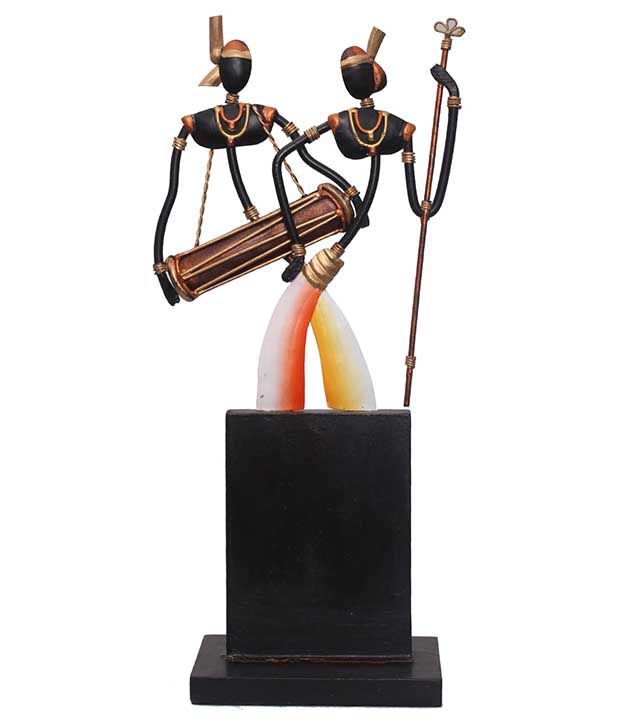ॐ श्री गुरुभ्यो नमः ॐ श्री शिवानन्दाय नमः ॐ श्री चिदानन्दाय नमःॐ श्री दुर्गायै नमः
Hindi Bengali Tamil Marathi Telugu Malayalam Kannada Sanskrit Assamese Gujarati Konkani Odiya Punjabi
Source of all Images in this Blog-post : Google Images : ‘Google Image Search’ will reveal the multiple sources of every single image shared here. For more details, kindly see ‘Disclaimer‘

Bastar Iron Craft also known as ‘Wrought iron craft of Baster’ is a traditional Indian iron crafts that are manufactured in the Bastar district of Chhattisgarh state in India.
The iron-crafting work has been protected under the Geographical Indication (GI).

The iron craft skill is passed through generation to generation in Bastar region. Some tribal communities are experts in iron craft work and many of them became as iron-smiths.
Among many communities Gondi and Maria are notable for the traditional iron-crafting.
Bastar region of Chattisgarh is one of the richest areas in terms of iron ore deposits. Tribal, particularly Gond and Maria, specialized themselves in extracting iron from the iron ores, thus forming ironsmith communities in the tribe.
The community started catering to the needs of the tribe by providing them tools for agriculture, jungle cutting tools, arrowheads and knives for hunting. Their skill evolved with time as well as experimentation with material and technique.

Gond tribe worships ‘Budha dev’ as God, which was believed to reside in saja tree, also known as Indian laurel.
The tree was used for rituals and was believed to be sacred. It was considered as a symbol of strength by the local tribes.
But slowly when Gonds understood the strength of iron, they started believing that their God is in iron too.

Cemented platforms were built under the tree and iron tridents, spears and chains were kept as religious symbols. Ironsmiths started experimenting with the religious art forms.
They created wrought iron lamps (diya) and also decorated it with animal motifs. They started making figurines of Budha Dev riding a horse.
As their art evolved with time, their work also got noticed. Ironsmiths got the opportunity to travel to places with their craft and also learn from the exposure.
This resulted in more experimentation with the forms and sizes. This can be seen in the current form of the craft where an animal is depicted in various postures and sizes.

Bastar iron handicrafts have an aesthetic appeal in spite of its simplistic form. The art originated from the ironsmith community that used to make farming and hunting implements for tribes.
Over the years, the craft has beautifully evolved into an art form and so has its worldwide demand.
Wrought iron work is mainly concentrated in Bastar district of Chattisgarh with Kondagaon, Umargaon, and Gunagaon being the main centers.

The iron craft skill is passed from generation to generation in Bastar region. Some tribal communities are experts in iron craftwork and many of them became as iron-smiths. Among many communities, Gond and Maria are notable for the traditional iron-crafting.

Bastar region of Chattisgarh is one of the richest areas in terms of iron ore deposits. Tribal, particularly Gond and Maria, specialized themselves in extracting iron from the iron ores, thus forming ironsmith communities in the tribe. Their skill evolved with time as well as experimentation with material and technique.
Gond tribe worships ‘Budha dev’ as God, which was believed to reside in saja tree, also known as Indian laurel. But slowly when Gonds understood the strength of iron, they started believing that their God is in iron too.

The raw material used for the craft is predominantly recycled iron scrap, taken from household or market.
The main tools used are Dhukna Sar (furnace), Muthli (hammer), Chimtas (forceps), Sandasis (tongs) and Chenni (chisels).
These tools are made locally by the lohars themselves. The process starts with scrap iron being beaten repeatedly when hot. It requires no casting and molding.

The desired shape is given carefully by beating it at necessary spots. Then unnecessary portions are cut away and filed to remove sharp objects. On completion, varnish coat is applied to enhance the luster.
Both hollow and solid figures are made. For making a hollow figure, iron sheets are folded, cut and filed as per the need of the form. In a solid figure the main body parts are made first and then the detailing is done with the help of small chisels.

The craft that started from catering to farming, hunting, and ritualistic needs is now a beautiful work of art in demand.
Wrought iron products include Deepak, which is made of many shallow bowls like lamps (Diya), bird and animal figures, small diamond-shaped leaf-like structures and vertical and horizontal rods.
These Deepaks are the specialty of the ironsmiths in this area. These are available in the forms of Laman Diya (hanging diya) and Khut diya (stand diya).
Many new forms like masks, hangers, innovative lamps, wall hangings, and showpieces are also available.
A few YouTube Videos on Bastar Iron Craft
“A country remains poor in wealth both materially and intellectually if it doesnot develop its handicrafts and its handicrafts & handloom industries. It lives a lazy parasitic life by importing all the manufactured articles from outside”.
~ Mahatma Gandhi
